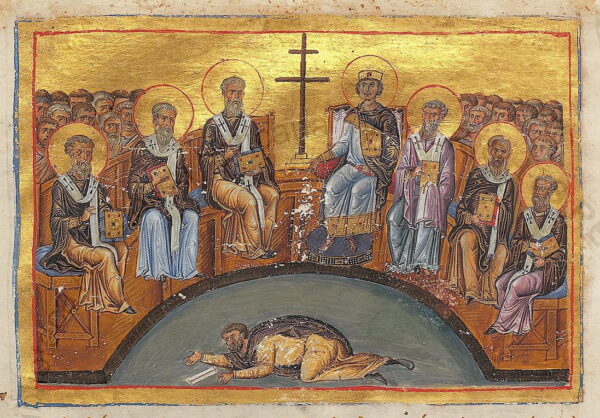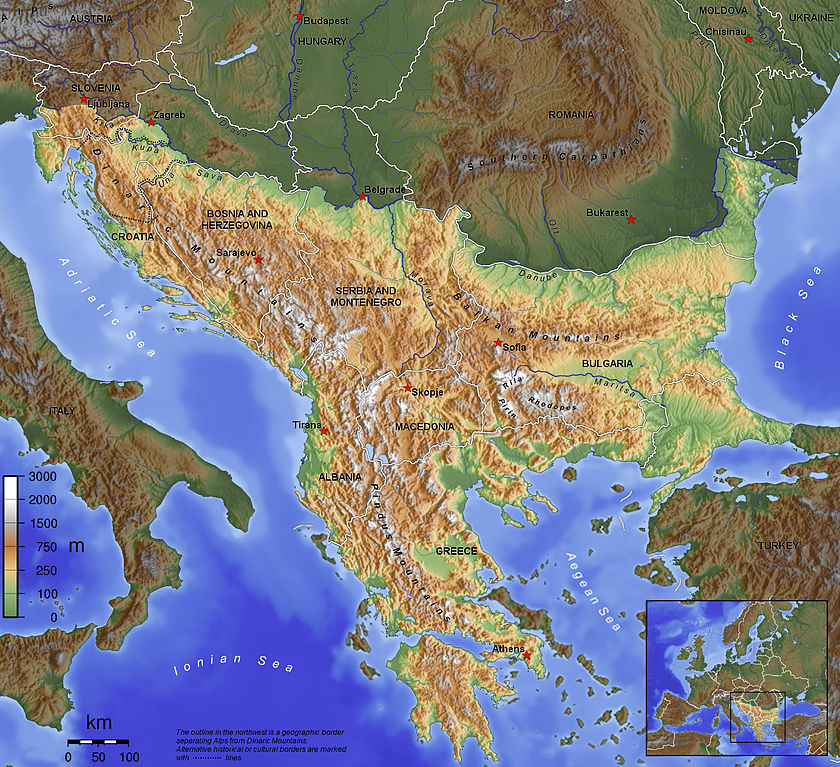In my 2015 journal from Scandinavia, I expressed surprise at the impact events in those three Nordic countries had on so much of European and, by extension, American history. Well, you can’t understand the Balkans without knowing its history. And when I write history, I mean much more than the recent history. Thus, before I start recounting the actual travel, I’m going to try and cover a few thousand years of regional history in barely as many words. Bear with me because I think it will help you make sense of what’s to come.
Much as the biblical account of the alleged 400 years of deity decreed slavery (Genesis 15:13) informs so deeply the Jewish view of the world, so too do centuries old events reverberate through the Balkans. I’ll write about this in more depth throughout the trip but, to give you some context, here is the statement made by Ratko Mladić when he led the Serbian Army into Srebrennica on 11 July 1995 shortly before the massacre of over 8,000 people:
He could be referring to one of two “recent” Serbian uprisings against the Ottoman Turks. The first occurred in 1804 and the second in 1813. Or he could be referencing the 1371 Battle of Maritsa where Turks annihilated Serbians. At best, then, his comment centers around a 180-year-old grudge and at worst, he is dredging up animosity that’s held sway for more than six centuries. It’s this worldview that, I think, demands at least a basic understanding of the long history of the region. While the ethnic problems that still trouble the Balkans today are more modern (meaning within the past three to four centuries) than ancient, the area has been subject to significant push and pull over several millennia.
A Brief Lesson in Regional Geography.
Let’s start by defining the Balkans. The Balkans are much more than the former Yugoslav Republics. After World War II, the country of Yugoslavia was comprised of six Socialist Republics: Bosnia and Herzegovina, Croatia, Macedonia, Montenegro, Slovenia, and Serbia. The latter was further divided to include the Socialist Autonomous Provinces of Kosovo and Vojvodina. Today, all but Vojvodina are independent nations.
However, geographically, the Balkan Peninsula is generally defined as the area in Southeastern Europe bordered by the Adriatic Sea on the west, the bits of the Mediterranean Sea called the Ionian and Aegean Seas on the south, and the Black Sea on the east. The northern boundary is generally considered the Danube, Sava, and Kupa Rivers. The countries currently considered to lie entirely within the Balkans are: Albania, Bulgaria, Bosnia and Hersegovina, Kosovo, (the Former Yugoslav Republic of) Macedonia, and Montenegro. (Update: FYROM became North Macedonia after a 2019 agreement with Greece.)
Because some geographers (particularly Italian ones) don’t consider Istria a part of the Balkans, Croatia is considered “mostly” within the Balkans. Other countries generally considered to be mostly or partially in the Balkans are: Greece (mainland), Romania, Serbia, Slovenia, and European Turkey. Together, this entire land area is about the size of Spain.
The Balkan Peninsula looks more or less like what’s seen on the map below:.
On this trip, I one day in Montenegro, about 10 days in Croatia, and three days each in Bosnia & Herzegovina and Slovenia. Consider my four day visit to Budapest, Hungary outside the Balkans. Now that you have an idea where and what the Balkans are, we can use this basic geography to aid our understanding of the region’s turbulent past.
Not simply Broad Brush but a Full Paint Roller Balkan History Mural.
During much of the time we might call pre-history, the two preeminent powers on the peninsula were Thrace – which controlled the far eastern corner of Greece, Bulgaria, and the European part of Turkey – and Macedon which controlled current day (North) Macedonia, much of the north central part of today’s Greece with its outlets to the Aegean Sea, and a portion of what is now Albania. When you think of Macedon, you might think of Phillip II whose son Alexander controlled a great empire. His decision to build his empire east toward Asia rather than west toward Europe likely helped the next great power, the Romans, arise and conquer the Balkans.
If you’re wondering about the western side of the peninsula (principally present-day Croatia) along the Adriatic coast, the area was dominated by various kingdoms of Illyria but Illyria consisted mainly of smaller kingdoms and never became a true regional power.
By the last quarter of the second century BCE, the Romans were beginning to feel their oats and began stretching their empire toward the east in an effort to protect their trade through the Adriatic. Rome established varying degrees of control over the area during the roughly 60-year period of the three major Illyrian Wars that stretched from 229 to 168 BCE.
The Great Schism Splits the Balkans.
The region remained relatively stable and prosperous until the third century of the common era before falling into about a century of conflicts and instability. Of course, the big transition during this time is the rise of Christianity throughout Europe and the Middle East. Saint Paul and Saint Andrew both traveled through the area spreading the new religion to both the Greeks and Romans. The number of Christians grew throughout the first three centuries CE and, in 313, Emperor Constantine the Great, who managed to return some stability to the area, issued the Edict of Milan effectively ending the Roman-sponsored persecution of Christianity. This made the area a haven for Christians. Then, in 325, Constantine assembled the First Council of Nicaea which settled many issues of theology and observation of canon law and by 391 Theodosius 1 had made Christianity the official religion of Rome.
Leap ahead to 476 and the fall of the Roman Empire. For the next 300 years or so, the main vestige of this once mighty force was the Byzantine Empire in the east. During this time, mostly in the sixth and seventh centuries, Slavs settled in the Balkans. The earliest reference to Serbs as a people occurred in the early ninth century. They occupied the peninsula in several small states in today’s Bosnia and Herzegovina, Montenegro, and Serbia plus a stretch along the Dalmatian coast.
All of this gets a bit knotted up but I’ll try to unravel it a bit here and in upcoming posts. First, along comes Pope Leo III who, in 800, crowns Charlemagne as the Holy Roman Emperor. This didn’t sit well with the powers in Constantinople because they viewed themselves as the rightful defenders of the faith. However, Leo’s choice is understandable given what was happening on that side of Europe.
Beginning in 780, the real power in Byzantium was wielded by Irene of Athens acting as the regent for her son Constantine VI. In 797, she made things official in a coup in which she blinded, imprisoned, and eventually watched her son die. While she was acting as regent, she called the Second Council of Nicaea – a move that likely didn’t sit well with the Pope – because, among other things, it restored the veneration of icons – a practice Rome had forbidden.
Skipping ahead a few more centuries, we land in the momentous year 1054. This is the year of the Great Schism (sometimes called the East-West Schism) and the formal split between the Roman Catholic and Greek (or Eastern) Orthodox Churches. Given centuries of ecclesiastical and liturgical differences, this split was all but inevitable.

[Image from Wikipedia – Public Domain.]
The putative straw dropped when Pope Leo IX sent a legation led by one Cardinal Humbert of Silva Candida to Cerularius, the Patriarch of Constantinople. Humbert’s main purpose was to seek help from the Byzantine Emperor to push back against the Norman conquest of southern Italy. Humbert refused to grant Cerularius the title of “Ecumenical Patriarch” and Cerularius refused to come to the Pope’s aid with the upshot that everyone excommunicated everyone else essentially making the schism official.
We needn’t get into all the factors that deepened the split between West and East and we’ll omit lengthy discussions about the Serbian dominion that controlled much of the peninsula. It’s important to note, however, that one Serbian family, the Nemanjić dynasty, was one of the most important in southeastern Europe between 1166 and 1371. Another important fact to keep in mind is that if you draw a line starting more or less along the Dalmatian coast toward Laçi in modern Albania through Sofia, Bulgaria and then along the Balkan Mountains to Varna on the Bulgarian Black Sea coast on the west, you will have a reasonable approximation dividing the Byzantine (Greek) and Latin influence of the peninsula. Combined with the establishment of the Serbian Orthodox Church by Ratsko Nemanjić in 1219, you build a modern-day Croatia that’s 83% Roman Catholic and a Serbia that’s 85% Orthodox and sow the seeds from which a troublesome flowering plant will grow.
Meanwhile, farther to the East, the third important religious group to occupy the Balkans is growing in number and power. These are the Ottoman Muslims. We’ll get to their influence in the next entry.
